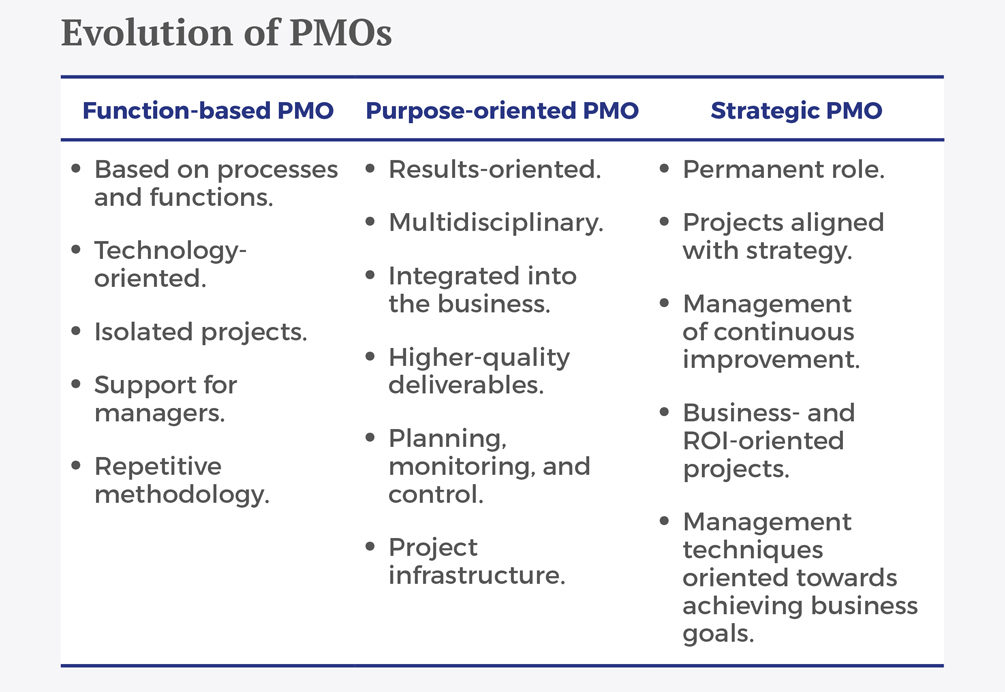The world is changing, and people and companies are changing along with it. Stark differences—even in comparison to the very recent past—are now readily apparent, and in recent years the pace of change has been much more frenetic than in the previous decades.
The corporate world has abandoned 20-year business models and shifted towards models with a horizon of just 20 months. In today’s rapidly changing world, we cannot be sure that any industry or product will still be around a few years from now.
The key to survival, therefore, is not just to define a good strategy but to implement it quickly and seamlessly, before it’s too late. Many companies have adopted a key tool that helps them achieve the best possible strategy implementation: the project management office (PMO), which I personally like to define as an organizational structure oriented towards portfolios, programs, and projects.
Surviving the transformation
Communication, transport, banking, energy, retail… Every sector you can imagine has undergone—or is undergoing—its own unique transformation. For many organizations, survival and competitiveness depend not on size but on the capacity to adapt. These companies are measured not in terms of what they produced in the past but what they are capable of producing. One clear example is the market valuation of Tesla’s capacity to produce future cash flows.
In many cases, it is obvious that the strategy behind a company’s objectives is essentially hot air: execution is completely decoupled from planning, and there are no projects that lend meaning to the established strategic plan. Projects are what make departments tick, so management must undergo its own transformation, abandoning outmoded approaches such as Gantt charts and the PERT technique. That’s where agile methodologies and “holistically” organized teams come in. With these approaches, the hierarchy is de-prioritized, analysis focuses on the whole rather than the parts, and all team members take part in a balanced decision-making process.
A quick word about agile methodologies: they haven’t actually invented anything new. Everything they apply is derived from the lean and kanban philosophies, which arose from the world of industrial production in the automotive sector.
A project manager must be prepared, within the context of a project, to execute a strategic vision and report back to general management.
What should project managers and PMOs be like?
As leaders, project managers should be perspicacious, well-informed, and capable of designing strategies for change. They must be familiar with strategy and financial management, know how to implement business plans through projects, and be efficient in their direction and management of projects. A project manager with this profile is sure to make a sustainable impact on the bottom line.
Equipped with a great business vision, a project manager must be prepared, within the context of a project, to execute a strategic vision and report back to general management. And they must do all this simultaneously, at the dizzying pace of today’s decision-making processes. In other words, PMOs must be as strategic as the business model itself.
A strategic PMO is a fixed unit with a permanent role; it doesn’t just pop up whenever a project begins. It defines agile lines of action and practices—with varying degrees of complexity, depending on the type of activity—to ensure that all projects “speak the same language.” Within the methodological framework thus defined, the purpose of a transformative PMO can be summed up as follows:
- To provide a global vision and make sure the various projects taking place within the organization are aligned with the company’s strategy.
- To manage the transversal coordination and development of the project portfolio.
- To plan activities with a shared vision.
- To oversee project deadlines, costs, risks, and results.
- To approve methodologies and tools for project development.
- To implement a culture of change and project-based management.
- To train managers and provide support for their plans (change management).
- To optimize resources.
- To improve the company’s bottom line.
This is an area for growth—open to all sorts of professionals and sectors—that has yet to reach maturity in many countries.
Specific training
Given the required skill set, it is clear that project managers are not born but made. Training is essential for these professionals, especially in the areas of general management, project management, and people management.
Building a PMO from scratch is surely one of the biggest challenges that organizations face today. Many companies have created such a unit in the hopes that it will act as an agent of transformation. This is an area for growth—open to all sorts of professionals and sectors—that has yet to reach maturity in many countries. The success of a PMO clearly depends on the impetus and support it receives from the company’s top brass.
The main benefit of a PMO is the ability to dovetail project planning with execution—in other words, to close the gap between words and deeds.

© IE Insights.











